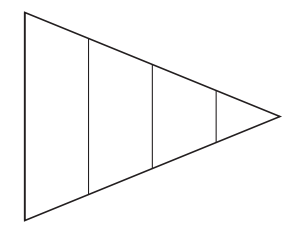Partition shapes into parts with equal areas. Express the area of each
part as a unit fraction of the whole. For example, partition a shape into 4
parts with equal area, and describe the area of each part as 1/4 of the area
of the shape.
| Course Number1111 |
Course Title222 |
| 5012050: | Grade Three Mathematics (Specifically in versions: 2014 - 2015, 2015 - 2022, 2022 - 2024, 2024 and beyond (current)) |
| 7712040: | Access Mathematics Grade 3 (Specifically in versions: 2014 - 2015, 2015 - 2018, 2018 - 2022, 2022 and beyond (current)) |
| 5001040: | Art – Intermediate 1 (Specifically in versions: 2014 - 2015, 2015 - 2019, 2019 - 2022, 2022 - 2024, 2024 and beyond (current)) |
| 5020100: | STEM Lab Grade 3 (Specifically in versions: 2016 - 2022, 2022 - 2024, 2024 and beyond (current)) |
| 7701035: | Access Art Grade 3 (Specifically in versions: 2018 - 2019, 2019 - 2023, 2023 and beyond (current)) |
| 5012055: | Grade 3 Accelerated Mathematics (Specifically in versions: 2019 - 2022, 2022 - 2024, 2024 and beyond (current)) |
| 5012015: | Foundational Skills in Mathematics 3-5 (Specifically in versions: 2019 - 2022, 2022 - 2024, 2024 and beyond (current)) |
| Name |
Description |
| Best Vegetable Garden | The students will plan a vegetable garden, deciding which kinds of vegetables to plant, how many plants of each kind will fit, and where each plant will be planted in a fixed-area garden design. Then they will revise their design based on new garden dimensions and additional plant options. Students will explore the concept of area to plan their garden and they will practice solving 1 and 2-step real-world problems using the four operations to develop their ideas. Model Eliciting Activities, MEAs, are open-ended, interdisciplinary problem-solving activities that are meant to reveal students’ thinking about the concepts embedded in realistic situations. Click here to learn more about MEAs and how they can transform your classroom. |
| Mystery Strips - Fractional Parts of the Whole | This problem-solving lesson has students working together in groups to discover that fractions are made up of equal parts of one-whole. In this lesson, students are exposed to equivalent fractions as well as challenged to work beyond unit fractions to discover the fractional part of one-whole that the "mystery strips" represent. This highly engaging lesson takes into account all levels of learners and will challenge even your most advanced students. |
| Discovering Fractions | In this lesson students will make initial discoveries about fractions. Students will work together to explain and record the discoveries they make while using manipulatives to explore fractions. |
| Fractions Meet Pattern Blocks | Students will identify the fractional parts of a whole using pattern blocks. There is a focus on unit fractions. |
| Fraction Counting Book | Students will make a book of fractions by counting by a specified denominator. They will represent the fractions as pictures, in number form, word form, and on a number line. |
| Fraction Folding - Part 2 | Students will use foldables to create and name fractions. Students will sing a song to learn the terms numerator and denominator. Students will identify how many unit fractions compose a fraction. |
| Fraction Folding-Part 1 | In this lesson, students will build the understanding of unit fractions. They will differentiate examples and non-examples of fractional parts of squares. They will label unit fractions and describe unit fractions as those that “build” other fractions. |

